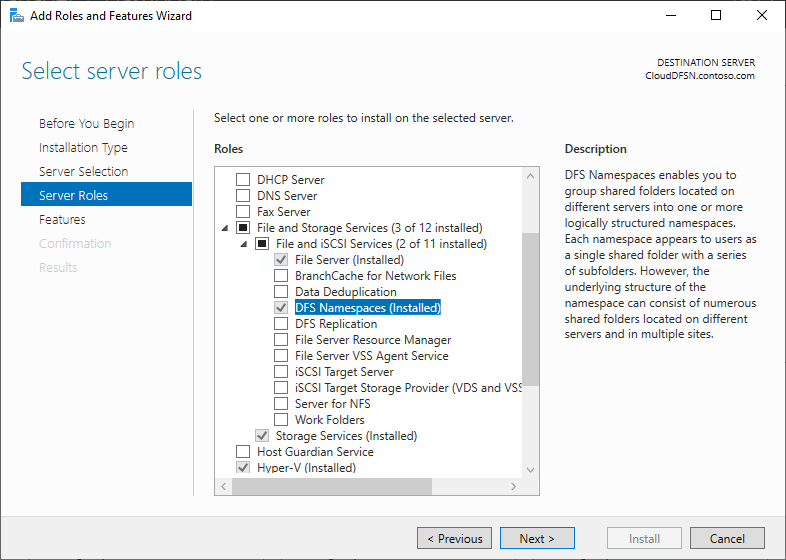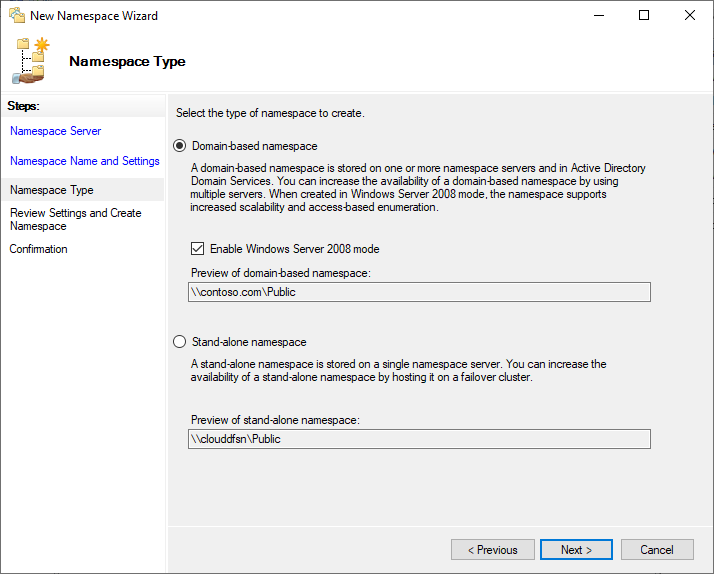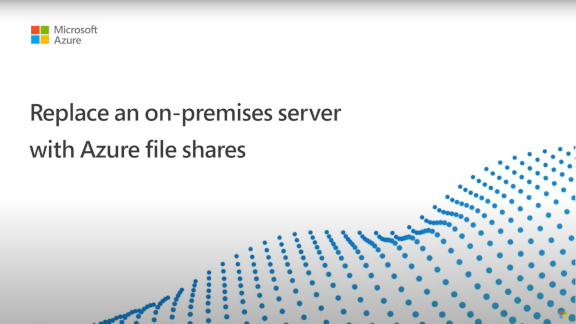Note
Access to this page requires authorization. You can try signing in or changing directories.
Access to this page requires authorization. You can try changing directories.
Distributed File Systems Namespaces, commonly referred to as DFS Namespaces or DFS-N, is a Windows Server server role that's used to simplify the deployment and maintenance of SMB file shares in production. DFS Namespaces provides storage namespace virtualization, enabling you to provide a layer of indirection between the UNC path of your file share and the actual file share. DFS Namespaces works with SMB file shares, agnostic of where those file shares are hosted. It can be used with SMB shares hosted on an on-premises Windows File Server with or without Azure File Sync, Azure file shares directly, SMB file shares hosted in Azure NetApp Files or other third-party offerings, and even with file shares hosted in other clouds.
At its core, DFS Namespaces provides a mapping between a user-friendly UNC path, like \\contoso\shares\ProjectX and the underlying UNC path of the SMB share like \\Server01-Prod\ProjectX or \\storageaccount.file.core.windows.net\projectx. When the end user wants to navigate to their file share, they type in the user-friendly UNC path, but their SMB client accesses the underlying SMB path of the mapping. You can also extend this basic concept to take over an existing file server name, such as \\MyServer\ProjectX. You can use this capability to achieve the following scenarios:
Provide a migration-proof name for a logical set of data. For example, you can map
\\contoso\shares\Engineeringto\\OldServer\Engineering. When you complete your migration to Azure Files, you can change the mapping to\\storageaccount.file.core.windows.net\engineering, such that when an end user accesses the user-friendly UNC path, they are seamlessly redirected to the Azure file share path.Establish a common name for a logical set of data that is distributed to multiple servers at different physical sites, such as through Azure File Sync. In this example, a name such as
\\contoso\shares\FileSyncExampleis mapped to multiple UNC paths such as\\FileSyncServer1\ExampleShare,\\FileSyncServer2\DifferentShareName,\\FileSyncServer3\ExampleShare. When the user accesses the user-friendly UNC, they are given a list of possible UNC paths and choose the one closest to them based on Windows Server Active Directory (AD) site definitions.Extend a logical set of data across size, IO, or other scale thresholds. This might be useful when dealing with user directories, where every user gets their own folder on a share, or with scratch shares, where users get arbitrary space to handle temporary data needs. With DFS Namespaces, you stitch together multiple folders into a cohesive namespace. For example,
\\contoso\shares\UserShares\user1maps to\\storageaccount.file.core.windows.net\user1,\\contoso\shares\UserShares\user2maps to\\storageaccount.file.core.windows.net\user2, and so on.
You can see an example of how to use DFS Namespaces with your Azure Files deployment in the following video overview.
Note
Skip to 10:10 in the video to see how to set up DFS Namespaces.
If you already have a DFS Namespace in place, no special steps are required to use it with Azure Files and File Sync. If you're accessing your Azure file share from on-premises, normal networking considerations apply. See Azure Files networking considerations for more information.
Applies to
| Management model | Billing model | Media tier | Redundancy | SMB | NFS |
|---|---|---|---|---|---|
| Microsoft.Storage | Provisioned v2 | HDD (standard) | Local (LRS) | ||
| Microsoft.Storage | Provisioned v2 | HDD (standard) | Zone (ZRS) | ||
| Microsoft.Storage | Provisioned v2 | HDD (standard) | Geo (GRS) | ||
| Microsoft.Storage | Provisioned v2 | HDD (standard) | GeoZone (GZRS) | ||
| Microsoft.Storage | Provisioned v1 | SSD (premium) | Local (LRS) | ||
| Microsoft.Storage | Provisioned v1 | SSD (premium) | Zone (ZRS) | ||
| Microsoft.Storage | Pay-as-you-go | HDD (standard) | Local (LRS) | ||
| Microsoft.Storage | Pay-as-you-go | HDD (standard) | Zone (ZRS) | ||
| Microsoft.Storage | Pay-as-you-go | HDD (standard) | Geo (GRS) | ||
| Microsoft.Storage | Pay-as-you-go | HDD (standard) | GeoZone (GZRS) |
Namespace types
DFS Namespaces provides two main namespace types:
- Domain-based namespace: A namespace hosted as part of your Windows Server AD domain. Namespaces hosted as part of AD will have a UNC path containing the name of your domain, for example,
\\contoso.com\shares\myshare, if your domain iscontoso.com. Domain-based namespaces support larger scale limits and built-in redundancy through AD. Domain-based namespaces can't be a clustered resource on a failover cluster. - Standalone namespace: A namespace hosted on an individual server, not hosted as part of Windows Server AD. Standalone namespaces will have a name based on the name of the standalone server, such as
\\MyStandaloneServer\shares\myshare, where your standalone server is namedMyStandaloneServer. Standalone namespaces support lower scale targets than domain-based namespaces but can be hosted as a clustered resource on a failover cluster.
Requirements
To use DFS Namespaces with Azure Files and File Sync, you must have the following resources:
- An Active Directory domain. This can be hosted anywhere you like, such as on-premises, in an Azure virtual machine (VM), or even in another cloud.
- A Windows Server that can host the namespace. A common pattern deployment pattern for DFS Namespaces is to use the Active Directory domain controller to host the namespaces, however the namespaces can be setup from any server with the DFS Namespaces server role installed. DFS Namespaces is available on all supported Windows Server versions.
- An SMB file share hosted in a domain-joined environment, such as an Azure file share hosted within a domain-joined storage account, or a file share hosted on a domain-joined Windows File Server using Azure File Sync. For more on domain-joining your storage account, see Identity-based authentication. Windows File Servers are domain-joined the same way regardless of whether you're using Azure File Sync.
- The SMB file shares you want to use with DFS Namespaces must be reachable from your on-premises networks. For more information, see Networking considerations for direct access.
Install the DFS Namespaces server role
If you're already using DFS Namespaces, or wish to set up DFS Namespaces on your domain controller, you may safely skip these steps.
To install the DFS Namespaces server role, open the Server Manager on your server. Select Manage, and then select Add Roles and Features. The resulting wizard guides you through the installation of the necessary Windows components to run and manage DFS Namespaces.
In the Installation Type section of the installation wizard, select the Role-based or feature-based installation radio button and select Next. On the Server Selection section, select the desired server(s) on which you want to install the DFS Namespaces server role, and select Next.
In the Server Roles section, select and check the DFS Namespaces role under File and Storage Services > File and ISCSI Services. When you select the DFS Namespaces server role, it might also add any required supporting server roles or features that you don't already have installed.

After you check the DFS Namespaces role, you can select Next on all subsequent screens, and select Install as soon as the wizard enables the button. When the installation is complete, you may configure your namespace.
Take over existing server names with root consolidation
An important use for DFS Namespaces is to take over an existing server name for the purposes of refactoring the physical layout of the file shares. For example, you may wish to consolidate file shares from multiple old file servers together on a single file server during a modernization migration. Traditionally, end-user familiarity and document-linking limit your ability to consolidate file shares from disparate file servers together on one host. However, the DFS Namespaces root consolidation feature allows you to stand up a single server to multiple server names and route to the appropriate share name.
Although useful for various data center migration scenarios, root consolidation is especially useful for adopting cloud-native Azure file shares because:
- Azure file shares don't allow you to keep existing on-premises server names.
- Azure file shares must be accessed via the fully qualified domain name (FQDN) of the storage account. For example, an Azure file share called
sharein storage accountstorageaccountis always accessed through the\\storageaccount.file.core.windows.net\shareUNC path. This can be confusing to end users who expect a short name (ex.\\MyServer\share) or a name that is a subdomain of the organization's domain name (for example\\MyServer.contoso.com\share).
Root consolidation may only be used with standalone namespaces. If you already have an existing domain-based namespace for your file shares, you don't need to create a root consolidated namespace.
Enabling root consolidation
Enable root consolidation by setting the following registry keys from an elevated PowerShell session (or using PowerShell remoting).
New-Item `
-Path "HKLM:SYSTEM\CurrentControlSet\Services\Dfs" `
-Type Registry `
-ErrorAction SilentlyContinue
New-Item `
-Path "HKLM:SYSTEM\CurrentControlSet\Services\Dfs\Parameters" `
-Type Registry `
-ErrorAction SilentlyContinue
New-Item `
-Path "HKLM:SYSTEM\CurrentControlSet\Services\Dfs\Parameters\Replicated" `
-Type Registry `
-ErrorAction SilentlyContinue
Set-ItemProperty `
-Path "HKLM:SYSTEM\CurrentControlSet\Services\Dfs\Parameters\Replicated" `
-Name "ServerConsolidationRetry" `
-Value 1
Creating DNS entries for existing file server names
In order for DFS Namespaces to respond to existing file server names, create alias (CNAME) records for your existing file servers that point at the DFS Namespaces server name. The exact procedure for updating your DNS records may depend on what servers your organization is using and if your organization is using custom tooling to automate the management of DNS. The following steps are for the DNS server included with Windows Server and automatically used by Windows AD.
On a Windows DNS server, open the DNS management console. You can find this by selecting the Start button and typing DNS. Navigate to the forward lookup zone for your domain. For example, if your domain is contoso.com, the forward lookup zone can be found under Forward Lookup Zones > contoso.com in the management console. The exact hierarchy shown in this dialog depends on the DNS configuration for your network.
Right-click on your forward lookup zone and select New Alias (CNAME). In the resulting dialog, enter the short name for the file server you're replacing (the fully qualified domain name is auto-populated in the textbox labeled Fully qualified domain name). In the textbox labeled Fully qualified domain name (FQDN) for the target host, enter the name of the DFS-N server. You can use the Browse button to help you select the server if desired. Select OK to create the CNAME record for your server.

Create a namespace
The basic unit of management for DFS Namespaces is the namespace. The namespace root, or name, is the starting point of the namespace, such that in the UNC path \\contoso.com\Public\, the namespace root is Public.
If you're using DFS Namespaces to take over an existing server name with root consolidation, the name of the namespace should be the name of server name you want to take over, prepended with the # character. For example, if you want to take over an existing server named MyServer, you would create a DFS-N namespace called #MyServer. The PowerShell example takes care of prepending the #, but if you create via the DFS Management console, you'll need to prepend as appropriate.
To create a new namespace, open the DFS Management console. You can find this by selecting the Start button and typing DFS Management. The resulting management console has two sections called Namespaces and Replication, which refer to DFS Namespaces and DFS Replication (DFS-R) respectively. Azure File Sync provides a modern replication and synchronization mechanism that may be used in place of DFS-R if replication is also desired.
Select the Namespaces section, and select the New Namespace button (you may also right-click on the Namespaces section). The resulting New Namespace Wizard walks you through creating a namespace.
The first section in the wizard requires you to pick the DFS Namespace server to host the namespace. Multiple servers can host a namespace, but you'll need to set up DFS Namespaces with one server at a time. Enter the name of the desired DFS Namespace server and select Next. In the Namespace Name and Settings section, enter the desired name of your namespace and select Next.
The Namespace Type section allows you to choose between a Domain-based namespace and a Stand-alone namespace. If you intend to use DFS Namespaces to preserve an existing file server/NAS device name, you should select the standalone namespace option. For any other scenario, select a domain-based namespace. Refer to namespace types for more information on choosing between namespace types.

Select the desired namespace type for your environment and select Next. The wizard will then summarize the namespace to be created. Select Create to create the namespace and Close when the dialog completes.
Configure folders and folder targets
For a namespace to be useful, it must have folders and folder targets. Each folder can have one or more folder targets, which are pointers to the SMB file share(s) that host that content. When users browse a folder with folder targets, the client computer receives a referral that transparently redirects the client computer to one of the folder targets. You can also have folders without folder targets to add structure and hierarchy to the namespace.
You can think of DFS Namespaces folders as analogous to file shares.
In the DFS Management console, select the namespace you just created and select New Folder. The resulting New Folder dialog will allow you to create both the folder and its targets.

In the textbox labeled Name provide the name of the folder. Select Add... to add folder targets for this folder. The resulting Add Folder Target dialog provides a textbox labeled Path to folder target where you can provide the UNC path to the desired folder. Select OK on the Add Folder Target dialog. If you're adding a UNC path to an Azure file share, you might receive a message reporting that the server storageaccount.file.core.windows.net can't be contacted. This is expected; select Yes to continue. Finally, select OK on the New Folder dialog to create the folder and folder targets.
Now that you've created a namespace, a folder, and a folder target, you should be able to mount your file share through DFS Namespaces. If you're using a domain-based namespace, the full path for your share should be \\<domain-name>\<namespace>\<share>. If you're using a standalone namespace, the full path for your share should be \\<DFS-server>\<namespace>\<share>. If you're using a standalone namespace with root consolidation, you can access directly through your old server name, such as \\<old-server>\<share>.
Access-Based Enumeration (ABE)
Using ABE to control the visibility of the files and folders in SMB Azure file shares isn't currently a supported scenario. ABE is a feature of DFS-N, so it's possible to configure identity-based authentication and enable the ABE feature. However, this only applies to the DFS-N folder targets; it doesn't retroactively apply to the targeted file shares themselves. This is because DFS-N works by referral, rather than as a proxy in front of the folder target.
For example, if the user types in the path \\mydfsnserver\share, the SMB client gets the referral of \\mydfsnserver\share => \\server123\share and makes the mount against the latter.
Because of this, ABE will only work in cases where the DFS-N server is hosting the list of usernames before the redirection:
\\DFSServer\users\contosouser1 => \\SA.file.core.windows.net\contosouser1
\\DFSServer\users\contosouser1 => \\SA.file.core.windows.net\users\contosouser1
(Where contosouser1 is a subfolder of the users share)
If each user is a subfolder after the redirection, ABE won't work:
\\DFSServer\SomePath\users --> \\SA.file.core.windows.net\users
See also
- Deploying an Azure file share: Planning for an Azure Files deployment and How to create an file share.
- Configuring file share access: Identity-based authentication and Networking considerations for direct access.
- Windows Server Distributed File System Namespaces
